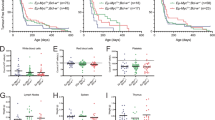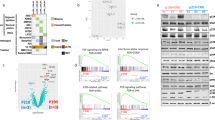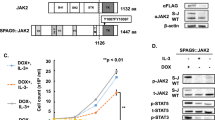Abstract
Mutations in the Bcr-Abl kinase domain are a frequent cause of imatinib resistance in patients with advanced CML or Ph+ ALL. The impact of these mutations on the overall oncogenic potential of Bcr-Abl and on the clinical course of the disease in the absence of imatinib is presently unclear. In this study, we analyzed the effects of the Bcr-Abl P-loop mutation Y253H and the highly imatinib resistant T315I mutation on kinase activity in vitro and transforming efficiency of Bcr-Abl in vitro and in vivo. Immunoprecipitated Bcr-AblY253H and Bcr-AblT315I proteins displayed similar kinase activities and substrate phosphorylation patterns as Bcr-Abl wildtype. We directly compared the proliferative capacity of mutant to wildtype Bcr-Abl in primary BM cells in vitro and in a murine transplantation model of CML by using a competitive repopulation assay. The results implicate that in the absence of imatinib, there is no growth advantage for cells carrying Bcr-AblT315I or Bcr-AblY253H compared to Bcr-Ablwt, whereas imatinib treatment clearly selects for leukemic cells expressing mutant Bcr-Abl both in vitro and in vivo. Thus, the analysed Bcr-Abl mutants confer imatinib resistance, but do not induce a growth advantage in the absence of imatinib.
This is a preview of subscription content, access via your institution
Access options
Subscribe to this journal
Receive 12 print issues and online access
$259.00 per year
only $21.58 per issue
Buy this article
- Purchase on Springer Link
- Instant access to full article PDF
Prices may be subject to local taxes which are calculated during checkout





Similar content being viewed by others
References
Pui CH, Relling MV, Downing JR . Acute lymphoblastic leukemia. N Engl J Med 2004; 350: 1535–1548.
Faderl S, Talpaz M, Estrov Z, O'Brien S, Kurzrock R, Kantarjian HM . The biology of chronic myeloid leukemia. N Engl J Med 1999; 341: 164–172.
Druker BJ, Talpaz M, Resta DJ, Peng B, Buchdunger E, Ford JM et al. Efficacy and safety of a specific inhibitor of the BCR-ABL tyrosine kinase in chronic myeloid leukemia. N Engl J Med 2001; 344: 1031–1037.
Druker BJ, Sawyers CL, Kantarjian H, Resta DJ, Reese SF, Ford JM et al. Activity of a specific inhibitor of the BCR-ABL tyrosine kinase in the blast crisis of chronic myeloid leukemia and acute lymphoblastic leukemia with the Philadelphia chromosome. N Engl J Med 2001; 344: 1038–1042.
Ottmann OG, Druker BJ, Sawyers CL, Goldman JM, Reiffers J, Silver RT et al. A phase 2 study of imatinib in patients with relapsed or refractory Philadelphia chromosome-positive acute lymphoid leukemias. Blood 2002; 100: 1965–1971.
Gorre ME, Mohammed M, Ellwood K, Hsu N, Paquette R, Rao PN et al. Clinical resistance to STI-571 cancer therapy caused by BCR-ABL gene mutation or amplification. Science 2001; 293: 876–880.
von Bubnoff N, Schneller F, Peschel C, Duyster J . BCR-ABL gene mutations in relation to clinical resistance of Philadelphia-chromosome-positive leukaemia to STI571: a prospective study. Lancet 2002; 359: 487–491.
Cortes JE, Talpaz M, Giles F, O'Brien S, Rios MB, Shan J et al. Prognostic significance of cytogenetic clonal evolution in patients with chronic myelogenous leukemia on imatinib mesylate therapy. Blood 2003; 101: 3794–3800.
Schindler T, Bornmann W, Pellicena P, Miller WT, Clarkson B, Kuriyan J . Structural mechanism for STI-571 inhibition of abelson tyrosine kinase. Science 2000; 289: 1938–1942.
Nagar B, Bornmann WG, Pellicena P, Schindler T, Veach DR, Miller WT et al. Crystal structures of the kinase domain of c-Abl in complex with the small molecule inhibitors PD173955 and imatinib (STI-571). Cancer Res 2002; 62: 4236–4243.
Azam M, Latek RR, Daley GQ . Mechanisms of autoinhibition and STI-571/imatinib resistance revealed by mutagenesis of BCR-ABL. Cell 2003; 112: 831–843.
Roumiantsev S, Shah NP, Gorre ME, Nicoll J, Brasher BB, Sawyers CL et al. Clinical resistance to the kinase inhibitor STI-571 in chronic myeloid leukemia by mutation of Tyr-253 in the Abl kinase domain P-loop. Proc Natl Acad Sci USA 2002; 99: 10700–10705.
Yamamoto M, Kurosu T, Kakihana K, Mizuchi D, Miura O . The two major imatinib resistance mutations E255K and T315I enhance the activity of BCR/ABL fusion kinase. Biochem Biophys Res Commun 2004; 319: 1272–1275.
Roche-Lestienne C, Lai JL, Darre S, Facon T, Preudhomme C . A mutation conferring resistance to imatinib at the time of diagnosis of chronic myelogenous leukemia. N Engl J Med 2003; 348: 2265–2266.
Hofmann WK, Komor M, Wassmann B, Jones LC, Gschaidmeier H, Hoelzer D et al. Presence of the BCR-ABL mutation Glu255Lys prior to STI571 (imatinib) treatment in patients with Ph+ acute lymphoblastic leukemia. Blood 2003; 102: 659–661.
Kreuzer KA, Le Coutre P, Landt O, Na IK, Schwarz M, Schultheis K et al. Preexistence and evolution of imatinib mesylate-resistant clones in chronic myelogenous leukemia detected by a PNA-based PCR clamping technique. Ann Hematol 2003; 82: 284–289.
Branford S, Rudzki Z, Walsh S, Parkinson I, Grigg A, Szer J et al. Detection of BCR-ABL mutations in patients with CML treated with imatinib is virtually always accompanied by clinical resistance, and mutations in the ATP phosphate-binding loop (P-loop) are associated with a poor prognosis. Blood 2003; 102: 276–283.
Gulick RM . Structured treatment interruption in patients infected with HIV: a new approach to therapy. Drugs 2002; 62: 245–253.
Hawley RG . High-titer retroviral vectors for efficient transduction of functional genes into murine hematopoietic stem cells. Ann NY Acad Sci 1994; 716: 327–330.
Pear WS, Miller JP, Xu L, Pui JC, Soffer B, Quackenbush RC et al. Efficient and rapid induction of a chronic myelogenous leukemia-like myeloproliferative disease in mice receiving P210 bcr/abl-transduced bone marrow. Blood 1998; 92: 3780–3792.
Miething C, Grundler R, Fend F, Hoepfl J, Mugler C, von Schilling C et al. The oncogenic fusion protein nucleophosmin-anaplastic lymphoma kinase (NPM-ALK) induces two distinct malignant phenotypes in a murine retroviral transplantation model. Oncogene 2003; 22: 4642–4647.
Miething C, Mugler C, Grundler R, Hoepfl J, Bai RY, Peschel C et al. Phosphorylation of tyrosine 393 in the kinase domain of Bcr-Abl influences the sensitivity towards imatinib in vivo. Leukemia 2003; 17: 1695–1699.
Yang F, Liu Y, Bixby SD, Friedman JD, Shokat KM . Highly efficient green fluorescent protein-based kinase substrates. Anal Biochem 1999; 266: 167–173.
Hochhaus A, Kreil S, Corbin AS, La Rosee P, Muller MC, Lahaye T et al. Molecular and chromosomal mechanisms of resistance to imatinib (STI571) therapy. Leukemia 2002; 16: 2190–2196.
Hochhaus A, Hughes T . Clinical resistance to imatinib: mechanisms and implications. Hematol Oncol Clin North Am 2004; 18: 641–656, ix.
Shah N, Nicoll J, Nagar B, Gorre M, Paquette R, Kuriyan J et al. Multiple BCR-ABL kinase domain mutations confer polyclonal resistance to the tyrosine kinase inhibitor imatinib (STI571) in chronic phase and blast crisis chronic myeloid leukemia. Cancer Cell 2002; 2: 117–125.
Azam M, Raz T, Nardi V, Opitz SL, Daley GQ . A screen to identify drug resistant variants to target-directed anti-cancer agents. Biol Proceed Online 2003; 5: 204–210.
von Bubnoff N, Barwisch S, Speicher MR, Peschel C, Duyster J . A cell-based screening strategy that predicts mutations in oncogenic tyrosine kinases: implications for clinical resistance in targeted cancer treatment. Cell Cycle 2005; 4: 400–406.
Allen PB, Wiedemann LM . An activating mutation in the ATP binding site of the ABL kinase domain. J Biol Chem 1996; 271: 19585–19591.
Corbin AS, Buchdunger E, Pascal F, Druker BJ . Analysis of the structural basis of specificity of inhibition of the Abl kinase by STI571. J Biol Chem 2002; 277: 32214–32219.
Jiang X, Stuible M, Chalandon Y, Li A, Chan WY, Eisterer W et al. Evidence for a positive role of SHIP in the BCR-ABL-mediated transformation of primitive murine hematopoietic cells and in human chronic myeloid leukemia. Blood 2003; 102: 2976–2984.
Willis SG, Lange T, Demehri S, Otto S, Crossman L, Niederwieser D et al. High-sensitivity detection of BCR-ABL kinase domain mutations in imatinib-naive patients: correlation with clonal cytogenetic evolution but not response to therapy. Blood 2005; 106: 2128–2137.
Acknowledgements
This work was supported by a grant from the BMBF (NGFN II) to JD. CM was supported by a fellowship from the Deutsche Jose Carreras Leukämie Stiftung (DJCLS2001/NAT-2).
Author information
Authors and Affiliations
Corresponding author
Additional information
Supplementary Information accompanies the paper on Leukemia's website (http://www.nature.com/leu)
Supplementary information
Rights and permissions
About this article
Cite this article
Miething, C., Feihl, S., Mugler, C. et al. The Bcr-Abl mutations T315I and Y253H do not confer a growth advantage in the absence of imatinib. Leukemia 20, 650–657 (2006). https://doi.org/10.1038/sj.leu.2404151
Received:
Revised:
Accepted:
Published:
Issue Date:
DOI: https://doi.org/10.1038/sj.leu.2404151
Keywords
This article is cited by
-
Aurora A Kinase Inhibitor AKI603 Induces Cellular Senescence in Chronic Myeloid Leukemia Cells Harboring T315I Mutation
Scientific Reports (2016)
-
Impact of FLT3-ITD location on sensitivity to TKI-therapy in vitro and in vivo
Leukemia (2016)
-
Grb10 is involved in BCR-ABL-positive leukemia in mice
Leukemia (2015)
-
Cks1 is a critical regulator of hematopoietic stem cell quiescence and cycling, operating upstream of Cdk inhibitors
Oncogene (2015)
-
Enhanced ABL-inhibitor-induced MAPK-activation in T315I-BCR-ABL-expressing cells: a potential mechanism of altered leukemogenicity
Journal of Cancer Research and Clinical Oncology (2012)



